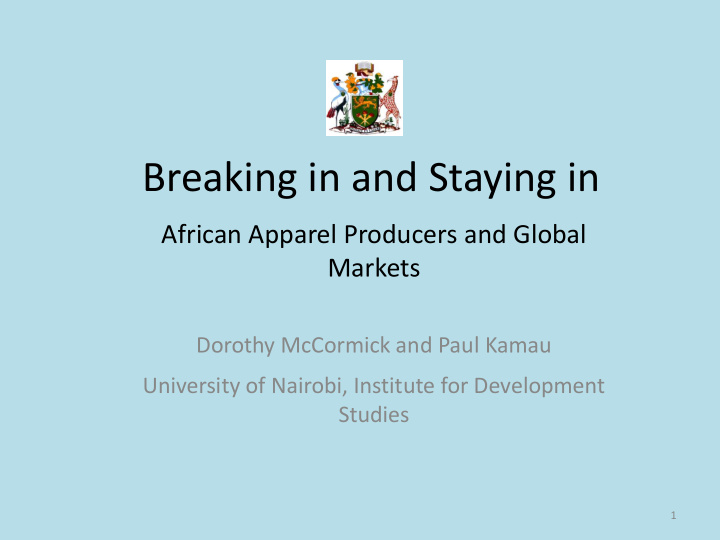



Breaking in and Staying in African Apparel Producers and Global Markets Dorothy McCormick and Paul Kamau University of Nairobi, Institute for Development Studies 1
Outline 1. Introduction 2. Apparel Firms in Five Countries 3. Continuing to Export 4. Conclusions 25 June, 2013 2
Introduction 1. Breaking in and staying in: – Africa’s post-MFA experience of Global Apparel Trade 2. Theoretical perspectives 3. Methodology 25 June, 2013 3
Staying in: Country experiences 2005-2011 $900 Millions $800 $700 $600 Mauritius Madagascar $500 Lesotho Kenya $400 Swaziland $300 $200 $100 $0 2005 2006 2007 2008 2009 2010 2011 25 June, 2013 4
Theoretical Perspectives Three bodies of theory informed the study: 1. Trade theory, especially new trade theory 2. Global value chains 3. Institutional approaches => Five possible explanations for differences in country performance 25 June, 2013 5
Possible Explanations for Differences in Country Performance 1. Favourable industrialisation and trade policies 2. Differing local resources 3. Differences in market destinations 4. Differences in industrial and product specialisation 5. Innovation 25 June, 2013 6
Methodology Primary data Coverage: • – Original study included seven countries; – This paper covers five of these: Kenya(16), Lesotho (19), Madagascar (18), Mauritius (20), and Swaziland (6) – Represents approximately 37% of population Unit of analysis was the firm • Data collection: Structured survey and selected case studies • Data analysis: • – Quantitative analysis of firm level data – Qualitative analysis of case study data Secondary data UN COMTRADE data used to generate country level trade graphs and • tables 25 June, 2013 7
Apparel Firms in Five African Countries 1. Firm size 2. Firm establishment and ownership 3. Country and product specialisation 4. Markets and competitors 5. Local resources 25 June, 2013 8
Firm Size Table 1: Employment Size by Country Employees Kenya Lesotho Madagascar Mauritius Swaziland Total Less than 100 1 0 0 1 0 2 100-499 5 9 5 11 2 32 500-999 3 2 5 2 3 15 1000-2999 6 6 7 4 1 21 Over 3000 1 1 1 1 0 4 missing 0 1 0 1 0 2 Total Firms 16 19 18 20 6 79 Source: Field data, 2011 25 June, 2013 9
Period of Firm Establishment 18 Number of 16 firms 14 12 10 before 2001 8 2001-2004 6 2005 - present 4 missing 2 0 Establishment Range: Country 1952 to 2010 25 June, 2013 10
Firm Ownership Overall distribution: Foreign owned 62% Joint ownership 10% Local ownership 28% Local ownership: Mauritius 85% Lesotho 5% 25 June, 2013 11
Industrial Specialisation - Country Specialisation in apparel: – Lesotho : 70% of manufacturing employment and 90% of total employment – Mauritius: 37.5% of manufacturing value added and 66.1% of manufacturing employment – Madagascar: 44% of exports and 60% of the manufacturing workforce – Swaziland: 25% of exports and a ‘high’ proportion of non-agricultural jobs – Kenya: Sector considered as ‘important’ in Vision 2030; accounts for 9.6% of manufacturing employment 25 June, 2013 12
Industrial Specialisation - Product Proportion of basics Average units of basic products Country (%) Swaziland 71.7 Kenya 71.5 Lesotho 59.5 Mauritius 58.1 Madagascar 28.9 Total 58.2 25 June, 2013 13
Market Orientation Firm-Level Market Orientation 35 30 25 20 US Dominant No. of Firms 15 EU Dominant 10 Africa Dominant 5 Diversified/other 0 25 June, 2013 14
Competitors 1. China – in all markets 2. Mauritius – in all markets 3. Bangladesh – in all markets 4. Other African countries – in all markets 5. India – in all export markets 6. Other Asian countries – in all export markets 7. Other countries – in EU and US markets only 25 June, 2013 15
Local Resources • Raw Materials – Problem of lack of local fabric • Labour – Serious shortage of high level technical skills in four out of five countries 25 June, 2013 16
Continuing to Export Post-MFA Stabilisation 1. More stabilisation: Mauritius and Kenya 2. Unclear: Lesotho 3. Less stabilisation: Madagascar and Swaziland $1,000 Millions $800 $600 $400 $200 $0 2005 2006 2007 2008 2009 2010 2011 25 June, 2013 17
Factors in Continuing to Export 1. Political stability 2. Local ownership 3. Industry support structures 4. Human resources 25 June, 2013 18
Conclusions African clothing industry is ‘jogging along’. It depends on trade preferences, expatriate skills, and imported fabric. Some countries are doing better than others, but all need help in reducing costs, diversifying markets, and investing in better skills, local raw materials, and new technologies. 25 June, 2013 19
Acknowledgements We are grateful to many, including: International Development Research Centre IDRC), Ottawa Canada, for funding to carry out the underlying research; Other members and resource persons of the African Clothing and Footwear Research Network (ACFRN) for their intellectual contributions (see www. acfrn.uonbi.ac.ke ; Factory owners and managers in each of the countries studied for their cooperation and assistance. Responsibility for errors and omissions is ours alone. 25 June, 2013 20
THANK YOU! 25 June, 2013 21
Recommend
More recommend